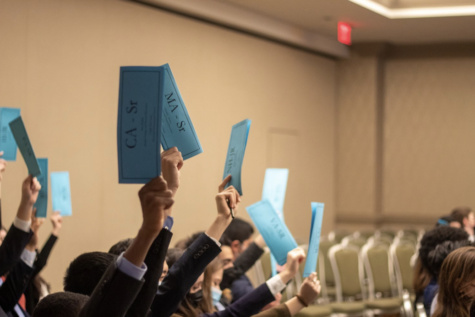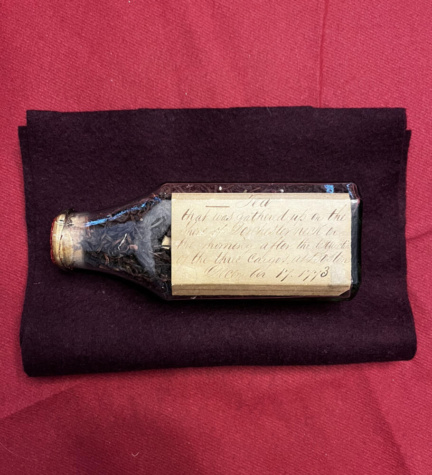
Nicolle Generaux | Newsroom Manager and Sophie Rapeepat | Writer
March 3, 2023
Just last week, sixteen members of the San Clemente High School Model Congress Club were lucky enough to attend the 2023 Harvard Model Congress in Boston, Massachusetts.
Since 1986, Harvard Model Congress has held the nation’s oldest government simulation conference – run entirely by Harvard undergraduates. Within this simulation, each delegate (student attending) is taught leadership skills in an “enjoyable and instructive atmosphere” that informs them of how the United States Government functions and reaches to create an interest in the legislative process. In a series of role-play scenarios, highschool students are invited to participate in “open debates, caucuses, trials, press conferences, testimonies, and crises” that cover federal issues currently argued in today’s politics.
Delegates were separated into 37 different committees, ranging from imitating the United States Supreme Court, to arguing in the House of Representatives, to debating about the Climate Crisis and the steps we can take nationally to resolve the issue. Each year, the undergraduate Harvard students running the Congress write a combined 1,000+ pages of reports explaining and providing research for each particular chosen debate subject – and with a delegate to staff ratio of 9:1, it is easy to see how dedicated the undergraduates are to this non-profit program.
“I had a blast at Model Congress,” commented junior Gabriella Nacelli. “The environment was intellectual and formal, yet also laid back and exciting.”
Each day, 1,500 delegates from 40 different high schools from around the country rushed to attend their assigned meetings in the Sheraton Marriott Hotel. In simple words, it was hectic: if it was even remotely close to 9:00 am, or the start of any committee meeting, all of the elevators were packed with delegates trying to get to the same floor – and if they were not crowding inside or in front of the elevators, they were dashing down the emergency stairs.
Although slightly chaotic because of the amount of people attending, it was rather easy to make friends because no one knew each other but we were all stuck in the same area. It was not uncommon for someone to walk up to a group of strangers and start a conversation as if they were friends. The benign environment allowed everyone to be comfortable socializing and conversing outside of the committees.
During the actual convention, many of the students attending came from private and prestigious schools, including the Navy and Army Academy, the Williams School, Trinity School, and much more. Honestly, it was intimidating at first because everyone from those schools were so well prepared for the Congress and obviously intelligent. However, most of them were encouraging, supportive, and friendly to everyone in their committees – so by the end of the first meeting, we were all comfortable enough to speak openly to each other and relax.
“In order to keep everything interesting and fun, my committee would take random dance breaks on our chairs,” added Nacelli. “Sometimes we would even storm other committees during their meetings chanting and spreading the fun.”
Not only did Harvard offer a once-in-a-lifetime experience at Model Congress, but Boston itself provided so many opportunities for sightseeing. Immediately after landing at the airport, our group visited the Boston Opera House for a production of Lin-Manuel Miranda’s Hamilton. The weather was cold but the snow was beautiful, and our trip in the subway was a fun introduction to city life.

On day two, we walked a few blocks to the Massachusetts Historical Society, where we received a private tour of the historical archives. On display were invaluable artifacts, including the Treaty of Paris, Abraham Lincoln’s personal pen, the first draft of the United States Constitution, and even a bottle of tea collected from the Boston Tea Party. The artifact that fascinated everyone was a letter written by ten-year-old Helen Keller in which she advocated for disability rights in perfect handwriting and grammar, despite her inability to see or hear. The librarians were extremely knowledgeable and patient when explaining the story behind each item. From there, our group was allowed free roam of the city, where we had our first meal in Boston; obviously, it was clam chowder.
Each day was packed with conferences, but in the short breaks we had between sessions, our group went on several tours. One morning we visited the Museum of Fine Arts and saw famous works that we had only ever read about in a textbook, such as paintings by Van Gogh and Picasso. Another time, we toured Harvard University and Boston College, receiving a glimpse of campus life. By far the best experience was traveling to North End, a neighborhood known as Boston’s “Little Italy.” There, we stuffed our faces with pasta and pastries before embarking on the Freedom Trail, a 2.5 mile long path that connects sixteen historically significant locations. We passed by Samuel Adam’s grave, Paul Revere’s home, and even the site of the Boston Massacre.
“I had so much fun walking through Boston,” junior Tatum O’Brien said when asked about her best memory. “The New England Holocaust Memorial we got to visit was beautiful and really tugged on my heartstrings.”
Even though the trip only lasted six days, it was definitely a memorable experience and is recommended by all who attended.

Leave a Reply